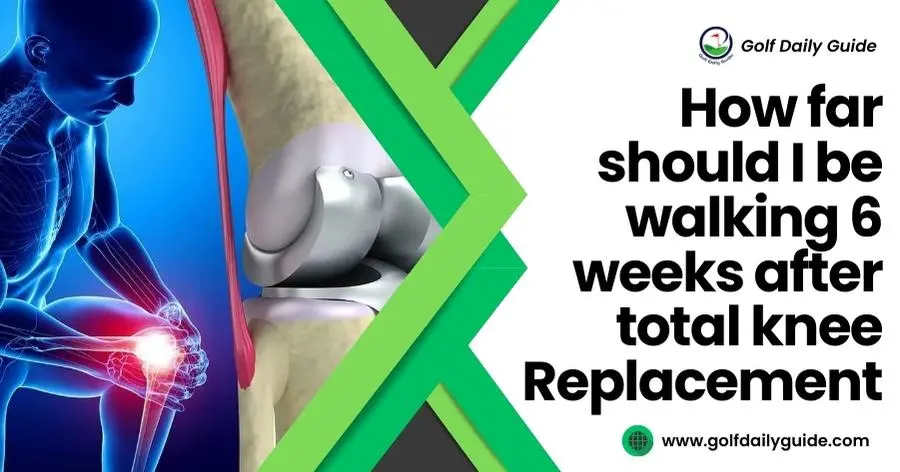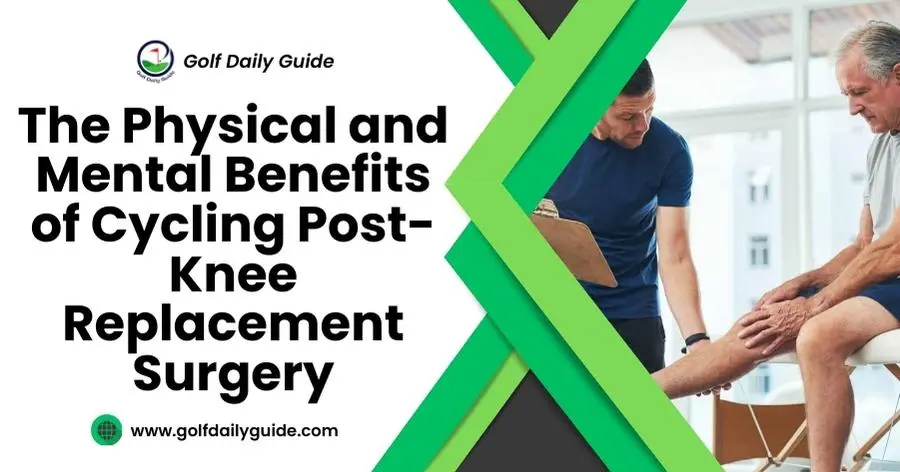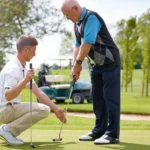Are you considering getting back into golf after undergoing a knee replacement? Following such significant surgery, many golf enthusiasts wonder when it’s safe to return to the sport.
To ensure a smooth and successful transition back to golf, consider various factors and professional advice.
If you’re a golf enthusiast who has recently had knee replacement surgery, you may be wondering, “Can I play golf 6 weeks after knee replacement?”
This blog will provide you with valuable insights into returning to golf after knee replacement, allowing you to make an informed decision about the future of your golfing career.
So, let’s tee off and delve into this important topic!
How soon can I golf after knee replacement?
Golfing after knee replacement surgery is a common concern for many individuals who enjoy the sport. A gradual return to golf is important to ensure a smooth recovery and to avoid any complications.
In general, many individuals can return to golfing approximately 3 to 6 months after knee replacement surgery.
However, this timeline is not set in stone, and it’s crucial to follow your surgeon’s specific recommendations.
In the early stages of recovery, your focus should be on rehabilitation and physical therapy.
Your physical therapist will guide you through exercises and movements that will prepare you for a gradual return to your normal activities, including golfing.
Before heading back to the golf course, consider the following tips:
1. Consult with Your Surgeon:
Before resuming golf, discuss with your orthopedic surgeon to ensure that you are physically ready and have received the green light to participate in the sport.
2. Start Slowly:
When you do return to golfing, ease into it. Begin with short sessions to assess how your knee responds to the movements and stresses involved in the game.
3. Use Proper Form:
Pay attention to your posture and swing mechanics to minimize stress on your knee. Consider working with a golf pro or physical therapist to refine your technique and prevent unnecessary strain.
4. Listen to Your Body:
If you experience pain, discomfort, or swelling during or after golfing, it’s important to take a step back and give your knee the rest it needs. Pushing through discomfort can hinder your recovery progress.
5. Consider Equipment Modifications:
Explore adaptive equipment options such as knee braces or modified golf swings if recommended by your healthcare team.
Remember that everyone’s recovery timeline is unique, and it’s essential to prioritize your overall well-being and long-term joint health.
By being patient and attentive to your body’s signals, you can gradually return to the golf course with confidence and enjoyment.
How far should I be walking 6 weeks after total knee replacement?
Can you play golf 6 weeks after knee replacement? Walking after a total knee replacement is an essential part of the recovery process. It helps improve strength, flexibility, and overall mobility.
However, it’s crucial to approach walking with a balance of progress and caution to ensure a smooth and successful recovery.

Here’s a comprehensive guide to help you understand how far you should be walking 6 weeks after total knee replacement:
Week 1-2: Taking the First Steps
During the first two weeks following a total knee replacement, your focus should be on gentle walking and regaining your balance and stability. Short, frequent walks with the aid of a walker or crutches are recommended. Your goal is to gradually increase the duration of these walks as your comfort and stamina improve. It’s important to prioritize rest and recovery during this initial phase.
Week 3-4: Building Strength and Endurance
As you progress into weeks 3 and 4, you can gradually transition from assisted walking to walking with a cane.
At this stage, aim to increase your walking distance while maintaining a steady pace. Pay attention to any discomfort or swelling, and adjust your walking routine accordingly.
It’s also beneficial to incorporate light stretching exercises to support muscle recovery and flexibility.
Week 5-6: Striving for Progress
By the 5th and 6th weeks post-surgery, you should be able to walk longer distances with reduced reliance on walking aids.
It’s essential to focus on maintaining proper posture and gait while walking. As your confidence and strength grow, consider introducing varied terrains and inclines into your walking routine to further challenge and improve your knee’s stability.
Factors to Consider
While the general timeline provides a framework for your walking progression after a total knee replacement, it’s important to remember that individual recovery experiences may vary.
Factors such as age, overall health, and the extent of knee damage prior to surgery can influence your walking capabilities.
Always consult with your orthopedic surgeon or physical therapist to create a personalized walking plan that aligns with your specific needs and recovery trajectory.
Listening to Your Body
Throughout the entire post-surgery walking process, it’s crucial to listen to your body. Pay attention to any signs of discomfort, swelling, or unusual pain during or after walking.
If you experience persistent or worsening symptoms, it’s imperative to seek medical guidance promptly.
Your healthcare team can provide valuable insights and adjustments to your walking routine to ensure a safe and effective recovery:
Celebrating Progress:
Recovery from total knee replacement surgery is a journey that requires patience, dedication, and perseverance.
Celebrate each milestone and improvement in your walking capabilities, no matter how small they may seem.
Maintaining a positive mindset and staying committed to your walking regimen can greatly contribute to a successful recovery and improved quality of life.
In conclusion, the journey of walking after total knee replacement is a gradual progression that requires attentiveness to your body’s signals and a collaborative approach with your healthcare providers.
Can you play golf 6 weeks after knee replacement
It’s natural to be eager to return to your favorite activities after knee replacement surgery.
Playing golf, with its combination of gentle walking, swinging, and focus, is a popular pastime for many individuals.
However, it’s crucial to approach the idea of playing golf after knee replacement with caution and consideration.

Consult Your Orthopedic Surgeon:
Before teeing off, it’s essential to consult your orthopedic surgeon. They will assess your individual progress and provide personalized advice on when it’s safe for you to return to golf.
The healing process following knee replacement can vary from person to person, making professional guidance indispensable.
Physical Therapy and Rehabilitation:
In the first few weeks after knee replacement, physical therapy and rehabilitation play a vital role in restoring strength and mobility.
Your therapist will guide you through exercises to improve flexibility and stability, gradually preparing you for the physical demands of golf.
It’s important to diligently follow your therapist’s recommendations to ensure a smooth transition back to the course.
Considerations for Golfing:
When the 6-week mark approaches and your surgeon gives the green light for golf, consider the following factors for a successful return:
1. Technique Adjustment:
Your golf swing may need to be modified initially to prevent strain on your healing knee.
2. Comfortable Footwear:
Invest in comfortable, supportive golf shoes to minimize pressure on your knee during each swing and stride.
3. Cart Use:
Opting for a golf cart instead of walking the course may be advisable in the initial stages of returning to the sport.
Returning to golf 6 weeks after knee replacement is possible for many individuals, but it requires careful consideration, professional guidance, and a mindful approach.
How long after surgery can you play golf?
Whether it’s a knee replacement, shoulder surgery, or any other procedure, the road to recovery can be filled with questions about when it’s safe to pick up the clubs again. Do want to know about Can you play golf 6 weeks after knee replacement?
I’ll explore the factors that determine when it’s appropriate to return to golf after surgery and offer some tips for a safe and enjoyable comeback:
1. Factors Affecting Recovery Time:
The time it takes to recover and return to golf after surgery can vary depending on several factors. The type of surgery, the individual’s overall health, and the specific demands of the golf swing all play a role in determining the appropriate timeline for resuming golf activities.
2. Type of Surgery:
Different surgeries have different recovery timelines. For example, a minor arthroscopic procedure may allow for a quicker return to golf compared to a major joint replacement.
It’s crucial to follow the advice of your surgeon and healthcare team regarding post-operative care and physical activity.
3. Overall Health and Fitness:
The patient’s overall health and physical condition also influence the recovery timeline. Those who are in good physical shape before surgery may experience a smoother and quicker recovery.
Following a rehabilitation plan and engaging in appropriate exercises can help regain the strength and mobility necessary for golfing.
4. Specific Demands of Golf:
Golf places specific demands on the body, particularly on the upper body, back, and lower body. The twisting motion of the golf swing, the weight transfer during the swing, and the walking involved in playing a round all impact the recovery process.
It’s essential to consider these demands when determining the appropriate time to return to the game.
Consulting with Healthcare Professionals:
Before making any decisions about returning to golf after surgery, it’s crucial to consult with healthcare professionals, including the surgeon, physical therapist, and any other relevant specialists.

They can provide personalized guidance based on the specific surgery, individual health and fitness, and the desired level of golfing activity:
1. Returning to Golf Safely:
When the time is right to return to the golf course, it’s essential to do so in a safe and gradual manner. Here are some tips for getting back on the green:
2. Start Slowly:
Begin with short practice sessions and gradually increase the duration and intensity of play.
3. Focus on Technique:
Pay attention to your swing mechanics and body movements to avoid putting excessive strain on the healing areas.
4. Listen to Your Body:
If you experience any pain or discomfort while playing, take a break and consult with your healthcare team.
5. Consider Equipment Modifications:
Depending on the surgery, you may need to make adjustments to your golf equipment or technique to accommodate any physical limitations.
Returning to golf after surgery is a process that requires patience, guidance from healthcare professionals, and a mindful approach to physical activity.
Remember, a gradual and cautious return to the game can help ensure a rewarding and enjoyable experience on the course.
Doctors suggested that patients ride a bike instead of playing golf
Doctors often recommend cycling as a great alternative to playing golf post-surgery. Now I’ll explore the reasons behind this recommendation and why cycling can be a beneficial and enjoyable activity for patients on the road to recovery.
Cycling vs. Golf After Knee Replacement Surgery: A Doctor’s Perspective
After undergoing knee replacement surgery, many patients are eager to resume their normal activities, including sports and recreational hobbies.
The repetitive twisting and stress on the knees during a golf swing can potentially strain the newly replaced joint, leading to discomfort and delayed healing.
On the other hand, cycling offers a low-impact, non-weight-bearing form of exercise that promotes joint mobility and muscle strength without putting excessive strain on the knees.
This makes it an ideal choice for patients looking to gradually reintroduce physical activity into their routine without compromising their recovery.
The Physical and Mental Benefits of Cycling Post-Knee Replacement Surgery
Cycling provides a range of physical and mental benefits that align with the goals of post-surgery rehabilitation.

Here are some key advantages:
1. Low-Impact Exercise:
Cycling is gentle on the joints and allows for smooth, circular motion without the jarring impact experienced in activities like golf swings or walking on uneven terrain. This promotes cardiovascular health and overall strength without overstressing the knees.
2. Improved Range of Motion:
The pedaling motion of cycling helps to improve flexibility and range of motion in the knee joint, facilitating the recovery process and reducing stiffness.
3. Muscle Strengthening:
Engaging the muscles in the legs and lower body while cycling helps to build strength and stability around the knee, supporting its long-term function and reducing the risk of injury.
4. Weight Management:
Regular cycling can contribute to weight management and overall fitness, which is crucial for maintaining joint health and reducing the strain on the knees.
5. Mental Well-being:
Cycling offers the opportunity to enjoy the outdoors, connect with nature, and experience the mental benefits of physical activity, such as reduced stress and improved mood.
It’s important to prioritize the gradual reintroduction of activities and listen to your body’s signals.
Cycling can serve as an excellent transitional activity during the initial stages of recovery, preparing the body for the eventual return to golf or other sports.
When Is It Safe To Play Golf?
Can you play golf 6 weeks after knee replacement? As an avid golfer, you must be eagerly waiting to get back on the course after your knee replacement surgery.
While every patient’s recovery timeline may differ, most doctors recommend waiting at least six weeks before returning to physical activities like golf.
This period allows your body to heal and regain strength, reducing the risk of complications or setbacks.
For many golf enthusiasts, the prospect of getting back on the fairway can provide much-needed motivation during the challenging recovery period.
However, it’s crucial to listen to your body and follow your surgeon’s guidance regarding when it is safe to resume playing golf.
Engaging in a comprehensive rehabilitation program can also help prepare your body for the physical demands of swinging clubs and navigating varied terrains on the course.
With patience and perseverance, you’ll soon find yourself back on the green, savoring each swing and relishing the joy that comes with playing golf once again.
Just remember that safety should always be a priority as you ease back into this rewarding pastime post-surgery.
What Do I Need To Do To Avoid An Injury To My Knee?
After a knee replacement, you should approach the recovery process with patience and caution if you’re eager to return to your favorite activities.
Six weeks after knee replacement surgery, most patients are still in the early stages of rehabilitation.
So, consult your surgeon or physical therapist before engaging in any strenuous or high-impact activity.
In the first few weeks after knee surgery, focus on low-impact exercises and activities that promote strength and flexibility.
So, This may include gentle walking, stationary cycling, and light resistance training. Your knee can be strengthened and stabilized gradually under professional supervision.
So, you can safely return to golf within a reasonable timeframe without complications.
Frequently Asked Question
Can I play golf six weeks after knee replacement surgery?
In many cases, patients can resume playing golf six weeks after knee replacement surgery. However, it’s crucial to follow your surgeon’s recommendations and receive clearance during your postoperative appointments.
Are there any specific precautions I should take while playing golf six weeks after knee replacement?
Yes, it’s important to avoid excessive twisting or pivoting on the replaced knee during the initial recovery period. Use a golf cart instead of walking the course and consider modifying your swing to minimize stress on the knee.
Can I walk the golf course instead of using a golf cart six weeks after knee replacement?
Walking the golf course may be allowed, but it’s essential to discuss this with your surgeon. They will assess your progress and guide on gradually increasing activity levels.
What signs should I watch for while playing golf that may indicate I’m pushing myself too hard?
Pain, swelling, or increased discomfort during or after playing golf may be signs that you are pushing yourself too hard. It’s crucial to listen to your body and adjust your activity level accordingly. If persistent, consult your surgeon.
Can I use a knee brace or support while playing golf six weeks after knee replacement?
The use of a knee brace or support after knee replacement surgery varies among individuals. Consult your surgeon to determine if using a brace is appropriate for your specific case and if it provides additional stability during golf activities.
Related Post
Can you play golf after hip replacement
Why golf is the hardest sport
Electric Golf Cart Bad Solenoid Symptoms
Can you jump a golf cart with a car
What is the gas golf cart problems
Final Thought about Can you play golf 6 weeks after knee replacement
In conclusion, preventing knee injuries requires a combination of strength training, proper form, and smart decision-making.
Exercises targeting the knee muscles, such as squats and lunges, can improve stability and reduce injuries.
Moreover, paying attention to warning signs such as pain or discomfort during physical activity is crucial for avoiding overuse injuries.
Incorporating rest days into your workout routine and listening to your body are equally important for maintaining healthy knees.
Thus, you can proactively protect your knees from injury by taking these preventive measures and staying aware of your body’s needs.












